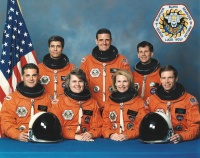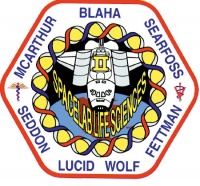STS-58
From The Space Library
 | |
| Organization | NASA-Office of Space Flight (United States),NASA Office of Life and Microgravity Sciences and Applications (United States) |
|---|---|
| Mission type | Engineering,Human Crew,Life Science |
| Launch date | October 18, 1993 |
| Launch vehicle | Space Shuttle |
| Launch site | Cape Canaveral, United States |
| COSPAR ID | 1993-065A |
| Inclination | 39 degrees |
| Experiments | Here |
| Alternate Names | SLS 2/STS 58,22869 |
| Additional Information | Here |
| PDMP Information | Here |
| Telecommunications Information | Here |
| Data Collection | Here |
| Payload Mass Up | 10517 kg |
| Payload Mass Down | 10540 kg |
| Orbiter | Columbia |
| Lift Off Mass | 2,054,530.91 kg |
| Orbiter Weight at Liftoff | 116,366.82 kg |
| Orbiter Weight at Landing | 104,433.18 kg |
| Landed | Concrete runway 22 at Edwards Air Force Base, Calif. |
| Orbits of Earth | 225 |
| Orbital Altitude | 153 nautical miles (176 statute miles) |
Contents |
[edit] Crew
- Commander: John E. Blaha
- Pilot: Richard A. Searfoss
- Payload Commander: M. Rhea Seddon
- Mission Specialist 1: Shannon W. Lucid
- Mission Specialist 2: David A. Wolf
- Mission Specialist 3: William S. McArthur Jr.
- Mission Specialist 4:
- Mission Specialist 5:
- Payload Specialist 1: Martin J. Fettman
- Payload Specialist 2:
ISS/Mir Crew Transport
[edit] Mission
STS 58 was the 15 flight of the orbiter Columbia. The primary payload for this mission was the second flight of the Spacelab Life Sciences (SLS 2) cargo bay payload. In addition to activities involved with the SLS 2 payload, seven experiments providing additional information for on-going medical studies supporting the Extended Duration Orbiter (EDO) Medical Project were performed. The EDO Medical Project is designed to assess the impact of long duration spaceflight (>10 days) on astronaut health, identify any operational medical concerns, and test countermeasures for the adverse effects of weightlessness on human physiology. Only three of the EDO experiments took place in-flight; the other four occurred prior and/or subsequent to the mission. An additional experiment performed on this flight was the Orbital Acceleration Research Experiment, or OARE. The main goal of the experiment was to measure the Shuttle's aeordynamic forces (drag) in orbit and during the early stages of re-entry. This was the third flight of this experiment. Astronauts also participated in the eleventh flight of the Shuttle Amateur Radio Experiment (SAREX).
[edit] EVA
[edit] Payload
Spacelab Life Sciences (SLS) 2; Shuttle Amateur Radio Experiment (SAREX) II
[edit] Books about the Space Shuttle Program
Buy This Book Click here |
Buy This Book here |
Buy This Book Click here |
Buy This Book Click here |





